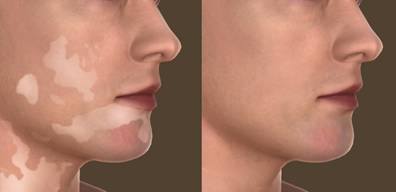Vitiligo Minigraft Surgery
Vitiligo is a skin condition of hypopigmentation causing development of light color patches or spots on the skin. Vitiligo may occur on all body parts but more often on hands, forearms, feet, and face. These spots are caused when the melanocytes (responsible for the color of the skin) are destroyed or are unable to perform their function. Vitiligo is caused due to hereditary problems, exposure to environmental risk factors, stress, or as adverse effect of certain drugs.
Vitiligo treatment includes medical therapy such as phototherapy, photochemotherapy, topical and systemic corticosteroids, other immuno-modulators, calcipotriol, pseudocatalase, vitamin supplementation and others.
Surgical procedures are performed if the medical treatment does not satisfactorily help. One of the methods is Minigrafting or punch grafting. Minigraft surgery is effective in those resistant to other treatments and in patients with segmental vitiligo.

Before After
Minigraft Surgery
Minigrafting is a surgical technique where patches of skin (minigrafts; varying in size, usually 1-3 mm) are harvested from the patient's unaffected skin, with the help of biopsy punch, and then grafted over the affected vitiligo sites. Donor grafts are typically harvested from the buttocks, hips or inguinal region. For facial grafting the grafts are usually taken from behind the ears. These harvested grafts have the layers of the skin which includes epidermis, dermis, and part of the subcutaneous tissue. After the recipient site holes have been prepared, the grafts are inserted and gently pushed into place. Skin adhesive and thin tape is applied to hold the grafts down. The area is then bandaged with non-adhesive gauze and a flexible wrap-like dressing. Phototherapy should be started one week after grafting as narrowband UVB light treatment helps accelerate the process of repigmentation. Because of the presence of melanocytes in the donor skin, the vitiligo areas gradually develop normal skin color.. The donor and recipient sites look their best after 6 months.
Complications can include scarring, cobble-stoning (bumpy appearance of the recipient sites), infection, incomplete color and/or mismatched color, and hyperpigmentation.
If you or your loved ones are suffering from vitiligo please consult Dr. Resnik for more information on minigraft surgery and if it is right for you.
Schedule your consultation with Dr. Resnik
